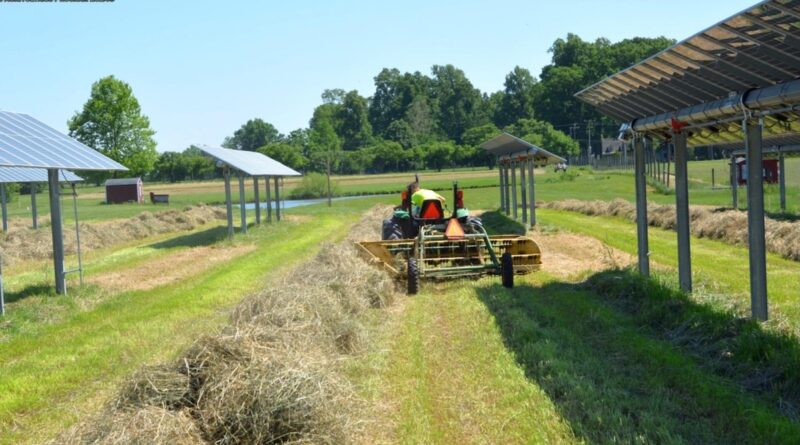New Agrivoltaic Solutions Keep Bubbling Up, Despite The Renewable Energy Clampdown
Support CleanTechnica's work through a Substack subscription or on Stripe.

This year’s U-turn in federal energy policy aside, it is not possible to stop the march of renewable energy innovation in the US, as amply illustrated by the latest iteration of the North American Agrivoltaics Awards program. The NAAA program is yet another sign that the agrivoltaic movement is transitioning from a patchwork of demonstration projects into a full fledged job-creating, farm-saving machine poised for widespread adoption, helping to sustain the nation’s agriculture industry through challenging times while adding more clean kilowatts to the electricity grid.
Agrivoltaics & The Solar Farm Summit
CleanTechnica has spilled plenty of ink on the emerging agrivoltaic side of the solar industry. Also called solar farming, agri-solar, agri-pv, and dual-use, the general idea is to provide room for farming activities in and around solar arrays. Meanwhile, farmers gain revenue by leasing their land to solar developers, or they can install their own solar panels to offset their electricity bills.
The movement has also birthed the ecovoltaics field, which focuses on native habitat restoration within solar arrays. Farms can host both agrivoltaic and ecovoltaic operations, such as pollinator habitats that benefit crop production and provide for soil restoration.
A growing network of supporting organizations demonstrates that the agrivoltaic movement has matured into an emerging industry over the years, with the annual Solar Farm Summit being one example. This year’s event took place in Chicago in August, focusing on the use of agrivoltaics to add an interlocking “stack” of value to farm operations, including ecosystem services and land conservation alongside energy generation and crop production.
Among other activities, the event hosted the North American Agrivoltaics Awards program, aimed at showcasing innovative projects that address regional challenges, climate change, food deserts, and other factors impacting farmers and their communities.
Agrivoltaic Award Winners Of 2025
The 2025 NAAA program included a Solar Farm of the Year award, shared jointly by Rutgers University in New Jersey and the Spaces of Opportunity community farm in South Phoenix, Arizona, to highlight the application of agrivoltaics across large institutions and small grassroots organizations alike.
With its “Farmers First” focus on productivity and profitability, Rutgers has earned widespread support for agrivoltaics within the New Jersey agriculture industry, including the state’s Highlands and Pinelands heritage and preservation regions. “Rutgers operates three research farms across New Jersey to study how solar can support crops and livestock without displacing them. From vegetables and hay to goats and cattle, the sites simulate real farm conditions and guide statewide policy,” NAAA explains, noting that the Rutgers program also supports New Jersey’s newly launched Dual-Use Solar Pilot Program.
The Rutgers effort builds on the state’s role as an early adopter of solar energy. New Jersey emerged as the #1 state for installed solar capacity in the early 2000’s and it currently holds the #12 slot for installed capacity, a respectable achievement for one of the nation’s smaller states by land area.
“New Jersey farmers have for the past several decades been actively integrating renewable energy into their operations as a way of reducing energy expenses, establishing additional income streams by selling solar-generated electricity back into the grid, and lowering their farms’ impact on climate change,” explains New Jersey Secretary of Agriculture Edward D. Wengryn in a write-up posted by Rutgers.
A Girl Scout Gold Award Community Farm Project
The Spaces of Opportunity project demonstrates how agrivoltaics can help community organizations alleviate local food deserts, even in regions not particularly conducive to farming. The farm, which also earned a Girl Scout Gold Award, deploys its solar panels to buffer hundreds of transplants from harsh growing conditions. The produce is donated to schools, food banks, farmers markets, and other local organizations.
“What makes this agrivoltaics project exceptional is its combination of real-world application, scientific research, and educational value,” NAAA explains. “The team is collaborating with the USDA Arid Land Research Center to monitor plant yields, temperature impact, and other environmental benefits.”
“The data collected here will support a peer-reviewed paper and help farmers across the Southwest adopt climate-smart agriculture,” NAAA adds, taking note of a similar project called Gardens of Tomorrow. “Both installations offer tangible proof that solar and agriculture can work together, even in some of the hottest, most challenging urban growing environments in the country,” the organization emphasizes.
Everybody Loves Agrivoltaics
Rutgers and Spaces of Opportunity went up against some stiff competition this year. The other nominees were:
Colorado State University, a low-maintenance, durable system of bifacial solar fence arrays enabling row crop production (specifically, corn) applicable to diverse regions around the US.
Lettuce Shine, Oregon, a first-in-the-state agrivoltaic microgrid in a region with hot, dry summers that are getting hotter and drier alongside climate change, focusing on lettuce, spinach, and other heat-sensitive crops.
Madison Fields Solar Project, Ohio, the first agrivoltaic operation constructed by the leading solar developer Savion, which has partnered with the Ohio State University College of Food, Agricultural, and Environmental Sciences for crop testing as well as soil health monitoring, and trialing precision agriculture practices. The project also supports Savion’s “Between the Rows” initiative enabling utility-scale solar farms to create new opportunities for farmers.
Native Hill Farms Mobile Agrivoltaic Array, Colorado, a mobile, bifacial solar array that integrates seamlessly with the farm’s mobile greenhouse operation. The greenhouses move along tracks to enable cover cropping and other soil-based regenerative practices to take place on a rotating basis, while extending the growing season.
Ring Road Agrivoltaics Project, Massachusetts, a solar array over a cranberry bog that demonstrates how agrivoltaics can integrate with highly specialized heritage agricultural operations. The elevated panels help conserve soil moisture and shield the crop from heat stress while adding a new power generation resource to the electricity grid.
But Wait, There’s More
The 2025 NAAA program also opens a window into forthcoming agrivoltaic innovations in the US, with a “Solar Plan of the Year” award category covering the entire field of dual-use operations, meaning agrivoltaics, ecovoltaics, or both. With additional notes provided by NAAA, the 2025 finalists were:
Community Farm at Roundabout Meadows, Virginia: A small-scale, “yet deeply strategic installation that could have statewide ripple effects,” the project aims to identify shade-tolerant food crops with widespread application across diverse sites including rooftops, helping to launch agrivoltaic activity in the state beyond its current focus on grazing and pollinator habitats.
Denver Botanic Gardens, Colorado: This working farm hosts a 1.2-megawatt solar array shading vegetable crops, funded through Denver’s climate sales tax. When fully up and running the farm is expected to benefit income-qualified residents with up to 30,000 pounds of vegetables per year and discounted utility bills.
City of Detroit, Michigan: In a joint effort with the firm Lightstar, Detroit has introduced a multi-site urban farm project supported by agrivoltaic elements that decarbonize municipal buildings while enabling local communities to grow lettuce, kale, carrots, and berries among other crops. The program includes energy efficiency upgrades for local residents (see more details here).
The Plains Road Project, New York: Another Lightstar project, this 3.2 megawatt community solar project was enabled by an update to zoning laws, requiring dual-use projects to submit a farm plan. “This shift didn’t just pave the way for the Plains Road Project—it opened the door for other dual-use efforts in the region.” The zoning application included a 32-page farm plan developed by the firm Sol Ag Services.
UW Madison-Kegonsa Research Campus, Wisconsin: This “BadgerVoltaics” collaboration with Alliant Energy involves more than 130 faculty, staff, and students in dual-use research including both pollinator preservation and food production.
Washington State University Institute for Northwest Energy Futures: A $2.4 million grant from the state’s Department of Commerce supports this project in partnership with the European firm Sun’Agri. “INEF is addressing key challenges faced by orchardists—such as summer sunburn damage that can affect up to 50% of the fruit—while providing power for agricultural operations like irrigation and frost management…This demonstration site highlights the potential of agrivoltaics to reshape Washington’s apple industry, which accounts for 35% of U.S. domestic apple sales and spans over 50,000 acres.”
Next Steps For Farm Preservation In The US, Or Not
Against the backdrop of all this farmer-supporting agrivoltaic activity, a lot of bleating and braying over the wonders of coal has been heard from the Trump administration. It’s not clear how domestic coal producers can help US farmers, who are hanging by a thread, battered by the president’s tariff wars, inflation, worker shortages, extreme weather, and the shredding of financial assistance for clean energy projects.
On top of all that, this week has seen an abrupt halt to the basic Agriculture Department services upon which many farmers depend, a situation that will persist until the Republican majority in Congress decides to set the wheels of the US government in motion again. After all, they do hold the majority, with all the privileges, powers, and responsibilities conferred upon that status under our system of government.
If you have any thought about that, drop a note in the comment thread. Better yet, find your representatives in Congress and let them know what you think.
Photo (cropped): Solar farming innovators continue to push the envelope on agrivoltaic practices that combine farm productivity with renewable energy generation, habitat restoration, and soil conservation (courtesy of Rutgers University).
 Sign up for CleanTechnica's Weekly Substack for Zach and Scott's in-depth analyses and high level summaries, sign up for our daily newsletter, and follow us on Google News!
Sign up for CleanTechnica's Weekly Substack for Zach and Scott's in-depth analyses and high level summaries, sign up for our daily newsletter, and follow us on Google News!
Have a tip for CleanTechnica? Want to advertise? Want to suggest a guest for our CleanTech Talk podcast? Contact us here.
Sign up for our daily newsletter for 15 new cleantech stories a day. Or sign up for our weekly one on top stories of the week if daily is too frequent.
CleanTechnica uses affiliate links. See our policy here.
CleanTechnica's Comment Policy

